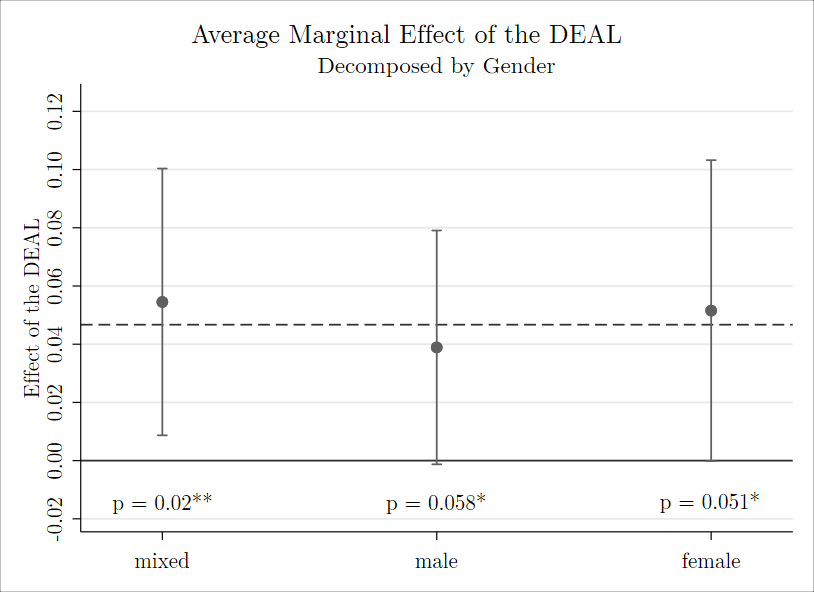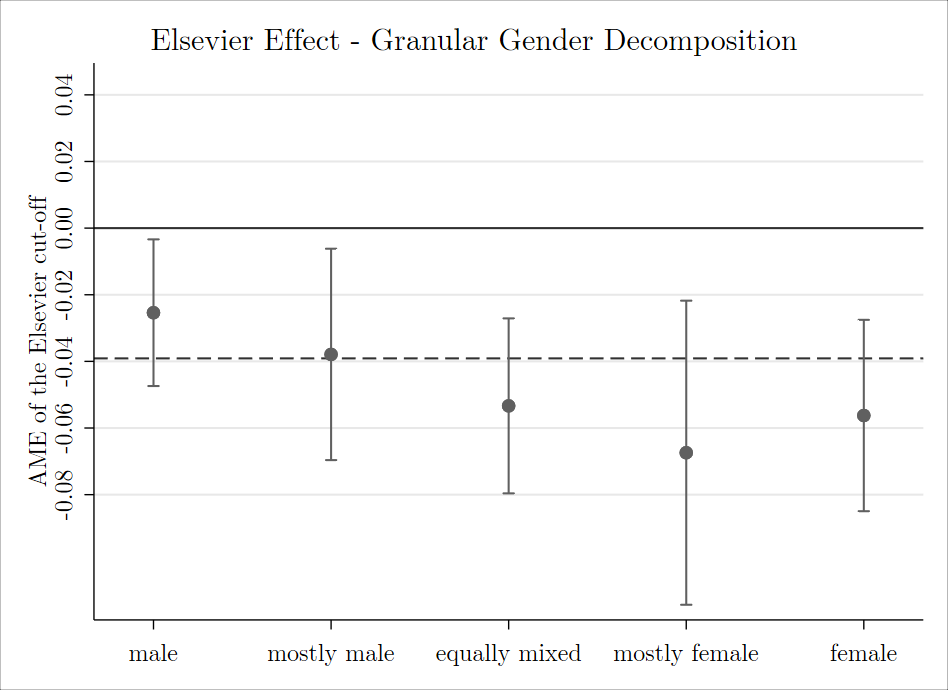
Gender Differences in Economics
Publication behavior in economics – Reputation, visibility, and the gender gap
Read a summary using the INOMICS AI tool
In recent times, debates on gender inequality among researchers at universities have emerged, in particular in economics. Even though leading academic societies have addressed these issues already for many years – for example, the American Economic Association has run the “Committee on the Status of Women in the Economics Profession” (CSWEP) since 1971, and the European Economic Association established its “Standing Committee on Women in Economics” (WinE) in 2003 – they appear to be persistent.
There exists a body of research that shows how women in economics face more obstacles than men when trying to make their way: Papers are less cited if the corresponding author is female (Maddi & Gingras, 2021). Further, women are confronted with higher standards in publishing compared to men (Hengel, 2022), a more hostile environment (Dupas et al., 2021; Wu, 2018), and they are less well-connected in their discipline, according to the count of women compared to men in the acknowledgments of published papers (Rose & Georg, 2021).
Publication differences by gender in economics
To further understand the gender gap in the discipline, it is also important to look at publication behavior, acknowledging, of course, that this can only be another puzzle piece in understanding the gap as a whole. This holds especially true for economics, as it is a discipline heavily driven by journal publications and the relative ranking of outlets in which a researcher’s papers appear.
In our recent working paper, Justus Haucap, Leon Knoke, and I use the negotiations for large-scale open access agreements between German research institutions and the leading academic publishers to study two unique natural experiments that answer the question: How do changes in the attractiveness of publishers and their journals affect the publication behavior of researchers in economics and adjacent fields?
Wiley and Springer Nature closed DEAL agreements that came into practice in 2019 and 2020, respectively. Under the conditions of these contracts, all submissions from authors affiliated with a German research institution are immediately published as open-access without further costs or paperwork for the researchers.
In contrast to the former two academic publishers, the negotiations with Elsevier were suspended in the autumn of 2016. As a consequence, 74 institutions canceled their Elsevier journal subscriptions. After a short break, Elsevier decided to continue granting access to institutions without contracts. At the end of 2017, a further 110 institutions terminated their contracts. Again, Elsevier continued to provide access to its outlets. The conflict ended with the German research alliance announcing its withdrawal from the negotiations in July 2018. Elsevier then cut off all institutions without a contract from access to its journals. If you want to access a publication now, you see something similar to the screenshot below that highlights that your institution does not subscribe to the content, and adds a prominent “purchase PDF” button.

Results of our study: women react differently than men to open access changes
In our working paper, we estimate a difference-in-differences model that looks at the effect of the varying publication incentives on the publication behavior of affected economists. While the two natural experiments (enacting DEAL and the end of negotiations with Elsevier) solely affected Germany, all other countries serve as a reliable control group. We decompose our effects by gender and the presence of co-authors and look at the effect across the quality scale. To do that, we rely on a dataset of scientific publications in economics ranging from 2015 to 2022 that contains some 240,000 observations.
For both events, we find significant baseline reactions. While the DEAL caused an increase in publications from authors based in Germany by +4.67%, the cut-off from Elsevier together with the negative press for the publisher reduced publications by -3.91% (both significant at the 5% level).
Looking closer at the gender differences, we find for the DEAL a larger effect for women than for men (at least significant at the 10% level) as the upper panel shows. In contrast, the lower panel for the Elsevier cut-off highlights that males do not significantly react (at the 5% level), but females do. Comparing the estimates also shows that they significantly differ for the comparison between male and mixed teams as well as male and female teams.


Here, we can already see that different gender compositions affect publication behavior in economics. Further decomposing the mixed-gender group, we are able to identify an almost steadily decreasing pattern in the point estimates for the Elsevier effect. While fully male authorships only show a decrease in Elsevier publications by some 2%, mostly and fully female research groups have an effect size approximately three times the size of their male colleagues, showing that they have reacted to the changes by publishing less in Elsevier.

When comparing behavior across the reputation or impact scale – using the Scimago Journal Rank criterion as a measure, we find important differences between men and women. We separate our data into four quartiles. The first quartile includes the journals with the lowest impact, and the fourth quartile, in turn, includes those with the highest. While researchers of both genders drop out of lower-tier Elsevier journals, men actually opt in to those Elsevier journals with the strongest impact, as the panels below show.


Based on these findings and further ones presented in our working paper, we conclude that women have a higher interest in the visibility of their research. As such, they contribute to the public good of open science freely accessible to all. In contrast, men seem to value reputation (of the higher-ranked Elsevier journals) more, which is clearly a private good.
The implications for gender differences in economics
The implications of these behavioral differences are twofold and, especially in academia, potentially severe. First, if the objective is to transform the market for academic publications, the `Elsevier experiment' raises doubts about the extent to which male researchers – who are predominant in most academic disciplines – contribute to this goal. Second, even though we observe a tendency toward open access in the lower ranks of the quality distribution, the behavior at the top appears to perpetuate not only the role of Elsevier, but the position of incumbent journals and publication patterns more generally.
Sticking to the status quo bears important advantages: Shifting away from well-off outlets may (negatively) affect the comparative career opportunities of women. In economics, publishing in the highest-ranked journal possible is of high importance. Excluding a publisher that hosts many influential journals may ultimately backfire on an individual’s career. It is even more severe for women who do this as publications have a larger impact on the careers of women than men (Lutter et al, 2022) and because women publish less than men (Xie & Shauman, 1998, Prpic, 2002).
To read more about the topic and view additional analysis, see the working paper:
Schmal, W. B., Haucap, J., Knoke, L. (2023). "The role of gender and coauthors in academic publication behavior". DICE Discussion Paper No. 397. https://www.econstor.eu/handle/10419/270608/
References:
Dupas, P., A. Sasser Modestino, M. Niederle, J. Wolfers, and T. S. D. Collective (2021). “Gender and the Dynamics of Economics Seminars”. NBER Working Paper 28494.
Hengel, E. (2022). “Publishing While Female: are Women Held to Higher Standards? Evidence from Peer Review”. The Economic Journal 132.648, 2951-2991
Lutter, M., I. M. Habicht, and M. Schröder (2022). “Gender differences in the determinants of becoming a professor in Germany. An event history analysis of academic psychologists from 1980 to 2019”. Research Policy 51.6. 104506
Maddi, A. and Y. Gingras (2021). “Gender diversity in research teams and citation impact in Economics and Management”. Journal of Economic Surveys 35.5, 1381–1404
Prpic, K. (2002). “Gender and productivity differentials in science”. Scientometrics 55, 27–58
Rose, M. E. and C.-P. Georg (2021). “What 5,000 acknowledgments tell us about informal collaboration in financial economics”. Research Policy 50.6, 104236
Wu, A. H. (2018). “Gendered language on the economics job market rumors forum”. AEA Papers and Proceedings 108, 175–179
Xie, Y. and K. A. Shauman (1998). “Sex Differences in Research Productivity: New Evidence about an Old Puzzle”. American Sociological Review 63.6, 847-870
Header image picture credit: Pixabay.com
-
- PhD Program
- Posted 4 days ago
Doctoral Program in Economics – 25 doctoral positions
Starts 1 Sep at Graduate School of Economic and Social Sciences (GESS), University of Mannheim in Mannheim, Germany
-
- PhD Program
- Posted 2 days ago
Graduate Program in Economics and Finance (GPEF) - Fully funded Ph.D. Positions
Starts 1 Sep at University of St.Gallen in Sankt Gallen, Switzerland
-
- Assistant Professor / Lecturer Job
- Posted 1 week ago
Clinical Assistant Professor in the Robert C. Vackar College of Business and Entrepreneurship/Economics
At University of Texas Rio Grande Valley in Edinburg, United States











